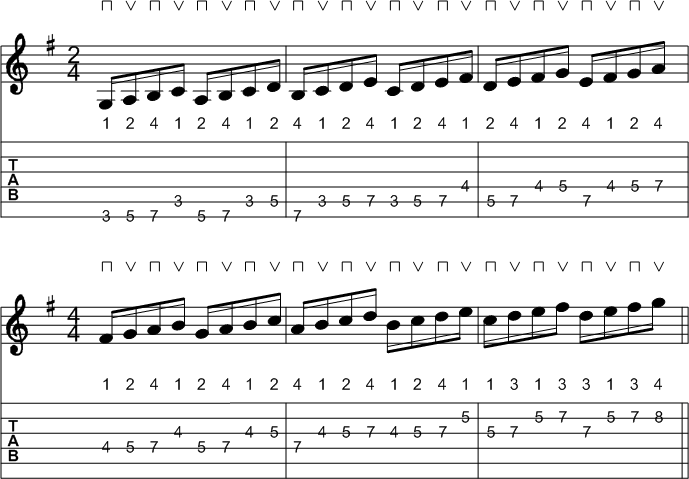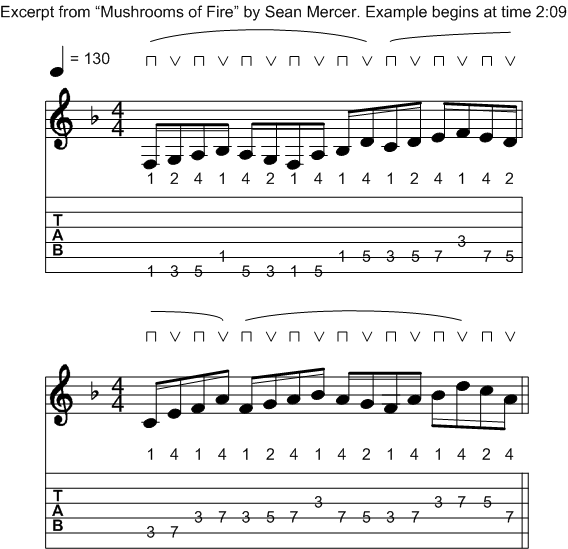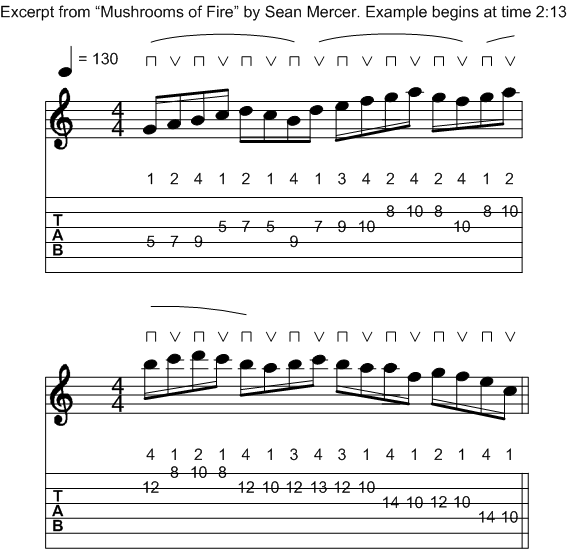A sequence is a musical pattern or motif (series of repeated notes) that is repeated at various intervals. A sequence can be of virtually any length. Many guitarists commonly practice sequences of 3 or 4 notes within their scalar exercises.
Example 1 is a simple ascending four-note sequence in the G major scale. The musical pattern or motif consists of four notes from the G major scale. Once the four-note group has been completed then the sequence is moved to the next scale tone and the pattern is repeated. This idea is continued throughout the example. You can continue this idea all the way up the fretboard.
This sequence is played with a 16th note rhythm (four notes per beat) and therefore repeats every beat. This type of sequence is very easy to feel as each repetition of the pattern coincides with a tap of the foot.

Many different sequences can be invented by creating an interesting four-note pattern and repeating it throughout a scale. Sequences do not have to be repeated on every degree (note) in the scale. You could choose to play your sequence starting on every third note in the scale for example. The possibilities are endless and are well worth the time to explore. Sequences can be used with any scale and in any key. Please experiment.
Don't stick with 16th note rhythms either. Make sure that you try creating and playing sequences with tripLet's (3 notes per beat) and 16th note tripLet's (6 notes per beat).
Example 2 is a twelve-note sequence in triplet rhythm played in the G major scale. The sequence begins with the B note at the 7th fret on the bass E-string. Once the 12-note pattern has been completed the sequence is repeated starting an octave higher with the B-note at the 9th fret on the G-string. You could continue this idea by starting the next sequence with the B-note at the 12th fret on the B-string. You do not have to repeat the sequence at octave intervals. You can choose any interval to repeat the sequence. Example 2 will sound great over diatonic chords in the G major scale, with G major, B minor and E minor being obvious candidates.

So far we have examined sequences that are relatively easy to feel because they have always started on a new beat (tap of the foot). But there is no reason why a sequence cannot have a different length - why not try sequences of five, seven or ten notes in duration?
A 16th note rhythm, for example, can be preserved throughout a run that uses sequences of odd length. This can result in a more interesting sounding run because the beginning of each musical sequence will not always align with a down beat (with a tap of the foot).
Let's look at some simple math. One bar of 'four four' time can be broken up into sixteen 16th notes (four beats with four notes each), making a total of sixteen 16th notes in a bar. Two such bars would require thirty-two 16th notes.
Example 3 is an extract from the solo section of "Mushrooms of Fire" from my "Electric Storm" CD and is played over an F major backing chord.

A 10-note sequence was played three times to get thirty 16th notes. Two additional 16th notes were added at the end of the second bar to complete the bar (making a total of 2*16=32 notes). The second time the sequence is played it begins in the middle of the third beat. The starting point for the third repetition of the sequence is on the second beat of bar 2. Phrase markings are included in example 3 to help identify the ten-note sequences.
In the "Mushrooms of Fire" solo, example 3 leads directly into example 4 shown below.

Example 4 demonstrates the use of seven note sequences over a G major backing chord. The second instance of the sequence begins on the last 16th note in the second beat. The third repetition of the sequence begins on the second 16th note of the last beat in bar 1. Three repetitions of the sequence produced a run that is 21 notes in length. An extra eleven 16th notes were then added to the end of the second bar make up two full bars of 16th notes.
The MP3 audio file is an extract from the "Mushrooms of Fire" solo. The audio sample plays through example 3 and example 4. After these four bars, the audio example leads directly into another two bars of 16th note tripLet's using twelve note sequences and finger tapping. These last two bars were described in detail as example 8 in my finger tapping column on Guitar9.com.
MP3 - "Mushrooms of Fire" solo extract
Hopefully these examples will have inspired you to create a few sequences of your own. Have fun, and don't forget to email me if you have any questions. Thanks for reading.
Sean Mercer is an accomplished producer, engineer, writer, guitarist, and keyboardist specializing in the neo-classical metal/fusion style.
His instrumental CD is entitled "Electric Storm".